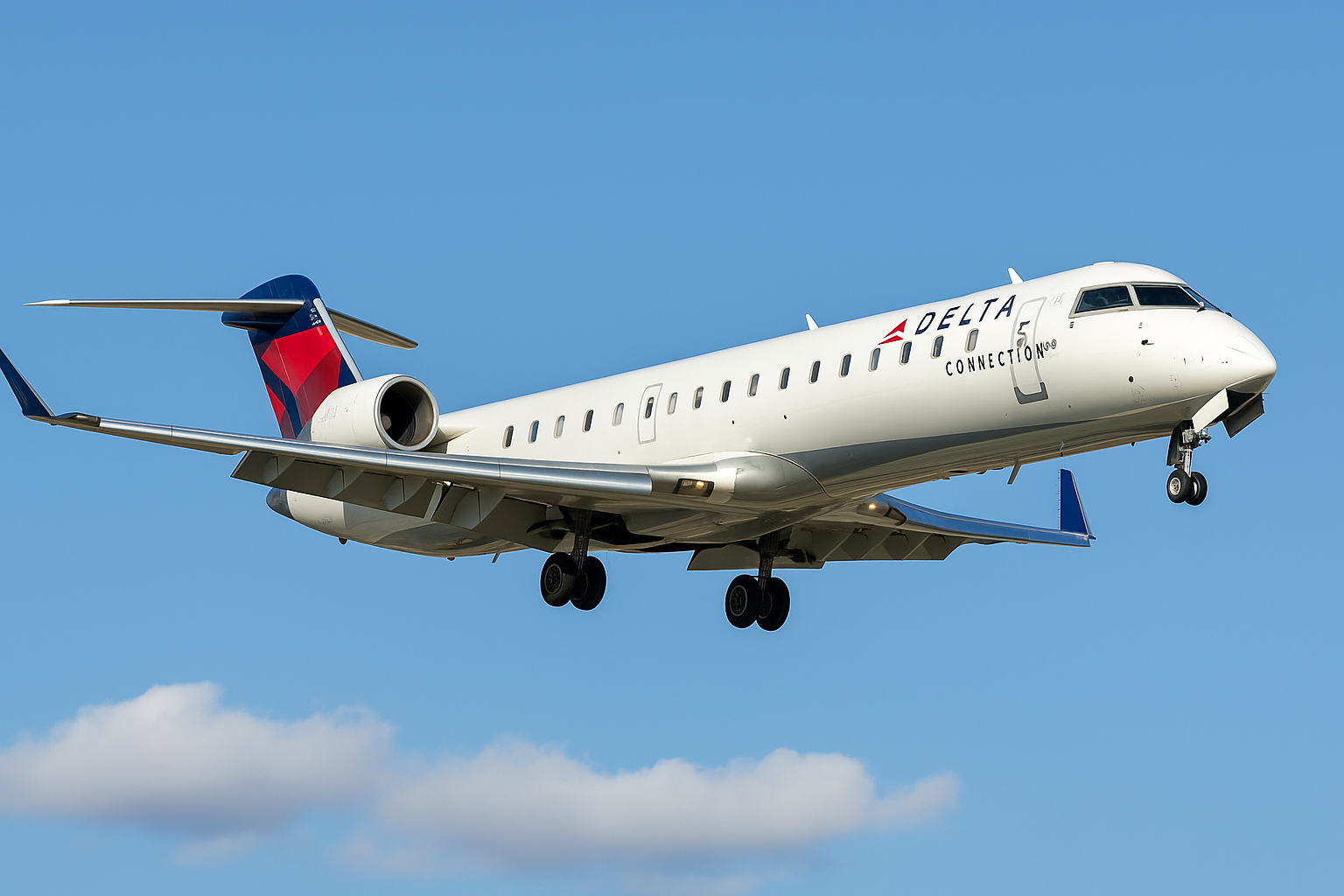Delta’s 56-Seat Jet Has First Class and Free Wi-Fi

On a quiet Delta Connection route, something surprising is happening: passengers are flying in First Class, enjoying complimentary Wi-Fi, and deplaning faster than on most mainline jets, all on a 56-seat aircraft. In an industry where tight margins and high density are the norm, Delta’s decision to maintain premium service on select small-capacity routes reflects a strategy that prioritizes consistency, loyalty, and passenger experience.
This isn’t just clever branding. It’s a real configuration flown daily on regional routes, using the Bombardier CRJ-700 and, in some cases, the CRJ-550, both operated by Delta’s regional affiliates like SkyWest and Endeavor Air.

The Aircraft: CRJ-700 and Delta’s 56-Seat Layout
Delta’s CRJ-700s in this configuration feature just 56 seats, nine in First Class, 12 in Comfort+, and 35 in the Main Cabin. Compared to high-density regional aircraft like the CRJ-900 or E175s that pack in up to 76 passengers, these jets offer a quieter, more spacious ride. The 2-1 First Class layout means no middle seats, and with fewer passengers onboard, boarding and deplaning move quickly.
While Delta has retired many of its smaller jets, it has selectively retained this configuration to serve markets where demand may not justify larger aircraft but where brand consistency matters. Routes like Detroit to Lexington, New York–LaGuardia to Richmond, or Cincinnati to Raleigh often see this type.

First Class Service, Regional Jet Style
Passengers in First Class receive many of the same perks offered on Delta’s mainline flights: priority boarding, complimentary snacks and beverages (including alcohol), and extra legroom with enhanced recline. Seat pitch typically runs 37–38 inches, a notable upgrade over Main Cabin’s 31 inches. The dedicated flight attendant in the front of the cabin serves the nine-seat section with personalized attention that’s often missing on larger jets.
Overhead bin space is limited compared to narrowbody aircraft, but gate-checking is smooth and quick. The smaller cabin also creates a quieter, more relaxed atmosphere, particularly attractive to business travelers on early morning or end-of-day flights.
Delta Sync Wi-Fi and Tech Access
Delta has been expanding its new Delta Sync Wi-Fi platform across both mainline and regional aircraft. These 56-seat jets are among those outfitted with high-speed Viasat Wi-Fi, providing streaming-quality internet gate-to-gate. As of 2024, SkyMiles members can log on for free — even in Economy — making Delta one of the only U.S. carriers to offer this level of connectivity across nearly all cabins.
The Sync portal includes personalized entertainment, destination guides, and shopping offers. While First Class passengers enjoy the most space, the Wi-Fi upgrade benefits everyone onboard, especially on work-heavy short hauls.
Sources: Delta.com Wi-Fi Overview
Why This Configuration Still Exists
So why does Delta still fly a smaller, high-service jet when most airlines are chasing bigger cabins and tighter seating?
It’s partly about the routes. These flights hit key business markets where what matters most is frequency, comfort, and showing up on time , not packing in more seats. Delta also cares about consistency. Whether you’re flying from Atlanta to Orlando or LaGuardia to Charlottesville, First Class should feel like First Class, even if the flight’s under 90 minutes.
And for their loyal flyers — Medallion members, corporate clients , the experience matters. Upgrades, comfort, and recognition shouldn’t vanish just because it’s a regional jet. Keeping that standard across the fleet is part of what keeps people coming back.

Passenger Reaction: Quiet Comfort and Elite Perks
Frequent flyers who’ve been on these routes often call them “hidden gems.” The reduced cabin size means faster boarding, more attentive service, and a flight experience that feels unusually calm compared to crowded mainline flights. For elites, it’s an easy upgrade route. For others, it’s a chance to experience First Class without the hustle of larger hub-to-hub corridors.
There are trade-offs: these jets lack seatback screens, the lavatory is smaller, and baggage space is tighter. But for many, the benefits — free Wi-Fi, smooth rides, priority boarding — far outweigh the limitations.
Regional Jet Strategy and the Future
Delta has been phasing out older, less efficient 50-seat jets like the CRJ-200. But the 56-seat version still fills an important gap. It’s useful for smaller markets that don’t need a big jet but still expect the Delta experience. These aircraft burn less fuel per passenger than the older models and allow for better onboard service.
In the future, Delta might shift more of these routes to newer planes like the Embraer E175. Still, the 56-seat CRJ makes sense where runway limits, demand, or tight schedules make bigger jets impractical.
Delta is working toward a consistent experience across all aircraft. With better cabins, Wi-Fi, and loyalty perks, these regional jets show you don’t need a massive plane to deliver a solid, high-end flight.
Final Thoughts
Delta’s 56-seat First Class routes don’t make headlines. But for passengers in the know, they’re some of the best rides in the system. Quiet, quick, well-serviced, and now connected with Delta Sync Wi-Fi, they show how smart fleet planning and passenger focus can come together in even the smallest airframes.
In a sky full of dense cabins and stripped-down service, Delta’s small premium jets are proof that flying small doesn’t have to mean flying less.
Looking for more unique aircraft stories like this? Visit our homepage to explore
Comments